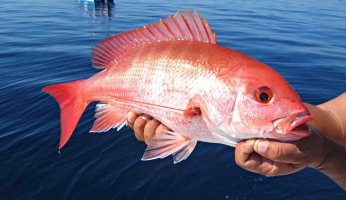A Kayak Guide for the Working Angler
 A Kayak Guide for the Working Angler
gearweare.net
A Kayak Guide for the Working Angler
gearweare.net
Kayak fishing has become a very large industry so large, in fact, that you seldom hear of any other uses for them. Just a few years ago kayaks were those things that fast water daredevils rode, gliding through river rapids and being flipped upside down while the rest of us watched with our breath held until the athlete reappeared, amazingly in an upright position. Now, with the recent interest in their application to fishing, kayaks designed specifically for fishing occupy a large proportion of store space in any retailer that sells them.
An even greater indication that kayak fishing has grown larger than anyone could have predicted can be seen in the ‘premium’ kayaks that are available for fishing. Some of the newest models reach the 4 and 5 thousand dollar range and look more like small boats than kayaks. In fact, many of them allow electric trolling motors, operate hands-free with the use of foot pedals, and have seats that shame large bass boats. There are currently television shows on the outdoor channels that are sponsored by these manufacturers who also sponsor fishing tournaments specific to kayak fishing.
The unavoidable question that arises from all of this excitement is how much is too much? When does a kayak become a boat and how much should the average, non-sponsored, working person spend on a kayak in order to get off of the bank and begin their own exploration of this sport? Hopefully, this article will assist you in making an informed decision and possibly save you some money as well.
Table of Contents
What is a kayak?
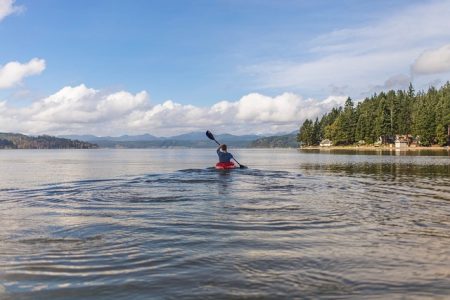
To begin with, when does a kayak become a boat? In my mind, this occurs when you can no longer manually carry (or at least drag) the device to the water from your vehicle. I would also suggest that we add the standard that if you find it is going to be easier to purchase a small trailer to transport it, you have probably departed from the kayak category. In addition, there are also state laws to consider. In many states, as soon as you add a motor (electric or otherwise) the vessel is categorized as a boat and must be registered and taxed as one. After all this, can we all agree that one of the biggest attractions to kayak fishing is the ability to ‘load and go’, as well as the freedom to get it into any small body of water that strikes our fancy?
I own a fishing type kayak, though this term has recently become very generic with so many models now available. Mine is about 8 years old and still going strong. It is one that you sit on top of, as opposed to inside of, and while it was one of the first to offer the ability to add an electric motor to it, I never did. My purpose in purchasing it was to fish in waters that I simply could not get my boat into, as well as any larger bodies of water where gas motors may not be permitted. I have also owned a small, lightweight, (and very affordable) traditional kayak that I have spent many hours fishing from. I will try to compare the two and describe how they differ. Then you can decide for yourself what is important to you and what may not be necessary after careful consideration.
My own experiences.
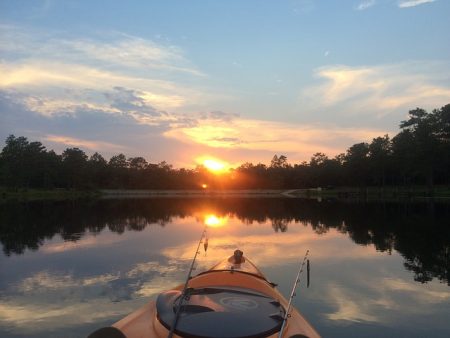
My fishing kayak is heavy. Not heavy, like the premium kayaks that weigh several hundred pounds after you add all of the gear and electric motors but heavier than a generic kayak. It weighs somewhere in the vicinity of 70 pounds which makes it a little cumbersome to load in the back of my truck. I lift one end onto the tailgate, and then slide it in from the other end. I then close the tailgate under it and strap it down. In all, it takes me 5 minutes or so to load. I like the fact that it is stable to sit on and this compensates for its weight in my mind. It does have some pre-molded rod holders in it, which I never use, and a supposed “dry compartment” which is one of the biggest lies that any kayak manufacturer has ever told. I keep my valuables in a separate ‘dry bag’ after learning the truth the hard way.
The standard kayak I bought, was purchased after I already owned the fishing kayak. This one weighed in at about 30 pounds and I could easily lift it and carry it with one hand. These are truly the fish anything, anywhere, vessel. They are nearly indestructible as well. I have thrown mine from bridge overpasses to get it into the water below, drug it through fields and yes, rolled it over a couple of times in the water. The only reason I no longer own this kayak is because I gave it to a friend who needed another one for his son so that they could fish together. The best part was, I paid less than $200.00 for it.
Now you are asking yourself, “Don’t I need a fishing kayak for fishing?” Not at all. I have caught plenty of fish from my traditional kayak and possibly even more than I have from my fishing kayak simply because I used it more. It was much easier to load and carry and we humans love the path of least resistance. There are some subtle differences, however, and I will spell those out for you now.
What are the differences?
Fishing kayaks are large (mine is 10 feet long) and they provide more storage space for gear. They are also less prone to roll over on their sides. You will discover though, if this is your first kayak, that you will only need (or want) a minimum of gear anyway. By the time you add the paddle and PFD, as well as a dry bag to keep your vitals in, things start to get crowded on any yak. A box of lures in your pocket and your rod will be your favorite companions.
Control.
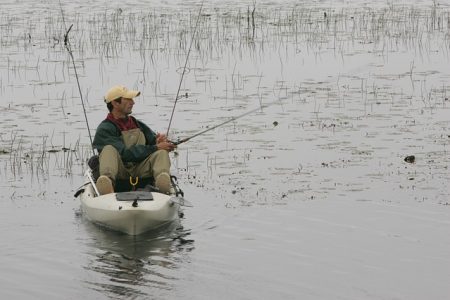
When fishing, neither type of kayak is easy to control. That is one of the challenges that all kayak fishermen face and to be honest unless you spring several thousands of dollars on the premium, foot controlled models, it just becomes part of kayak fishing. There are different ways to deal with this though, in different types of yaks. My fishing kayak is so large that I will occasionally take a small anchor with me. It doesn’t weigh much, though it is just one more thing that has to be loaded. There are also aftermarket kayak anchors that are simply long, fiberglass rods that you stick in the mud and they anchor you to one spot. These work on any style of kayak.
On my traditional kayak, I used to keep a small rope in it that allowed me to lash myself to protruding tree branches, limbs or rocks so that I could fish an area thoroughly without being carried out of position. This method works surprisingly well and the only thing required is to drill a small hole in the top lip of your kayak to tie off on.
One of the most overlooked remedies to this problem is probably the best. Assuming that you are using your kayak to fish small rivers and creeks, you can simply change the way that you fish. While in slow current it is easy to simply drift downstream and cast at targets as they appear but this is more difficult in faster water. So the solution is to use your kayak as a type of ‘water taxi’, using it to get from one point of land to the next. Instead of trying to fish from it, use it to get you to otherwise isolated patches of ground where you can dismount and fish while standing on the ground.
Accessories.
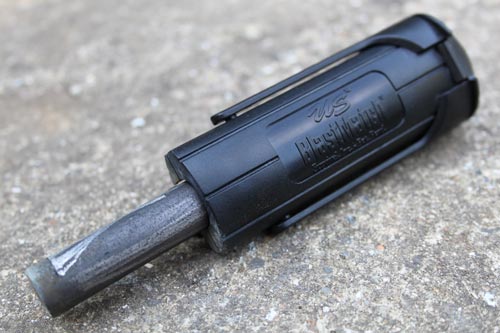
As I said at the beginning, the generic, discount kayak will most likely not come with rod holders. These are easily clamped on by purchasing aftermarket holders but you will find them less than useful in a kayak unless you are simply looking for a place to store your rod when you are not using it. Even when fishing with live bait from an anchored kayak, your vessel will not be stationary enough to use these effectively in that manner. I have seldom ever used mine, preferring to lay the rod across my lap most of the time.
Most generic, traditional kayaks will not have a paddle clip, where you place your paddle out of the way when you are not using it. All kayaks come with some sort of bungee cord attached to the top of them though, which works really well for sliding your paddle under the cords in order to get it out of the way. In fact, it’s easier than using the paddle clips on a fishing kayak, which never seem to hold very well and your paddle is tenuously secured at best.
Traditional kayaks are ‘tipsy’ compared to sit-on-top models but this is nothing you won’t adapt to. I discovered that anytime I felt myself leaning to one side or the other, I simply had to push both feet against the pedals inside the kayak and it would instantly straighten itself. Also keep in mind that you are fishing, not shooting rapids, so most of the water that you will be on will be mostly calm and flat anyway.
Which one is for you?
The reality is that you do not have to break the bank in order to get out on the water and reach fish that you’ve only dreamed about before. While the discount, traditional kayaks may not have the sex appeal that the higher end fishing kayaks do, they are just as functional. In many circumstances, you will be able to use it in areas that the owners of heavier kayaks cannot even consider. Much of your happiness with your purchase will depend on your own expectations of what you expect to get from your new kayak.
There is nothing quite like the solitude of floating silently down a small river or stream while surrounded by farmland and knowing that you are fishing water that is seldom if ever, fished. Hopefully, you have found this article helpful in the barrage of commercial images and sales pitches that always accompany any exploration of this topic. The best advice of all might be to see if you can borrow one type or another from a friend before laying down your hard-earned dollars. We all make mistakes but it is the expensive ones that stay with us the longest.






